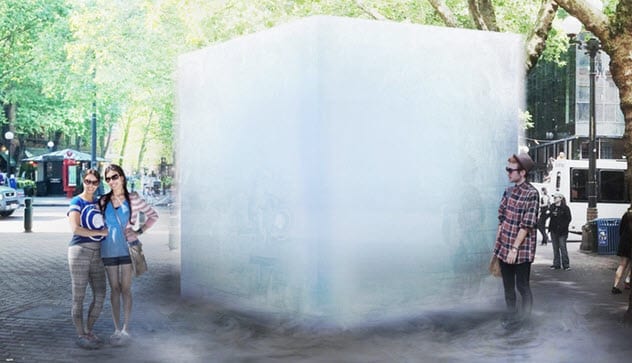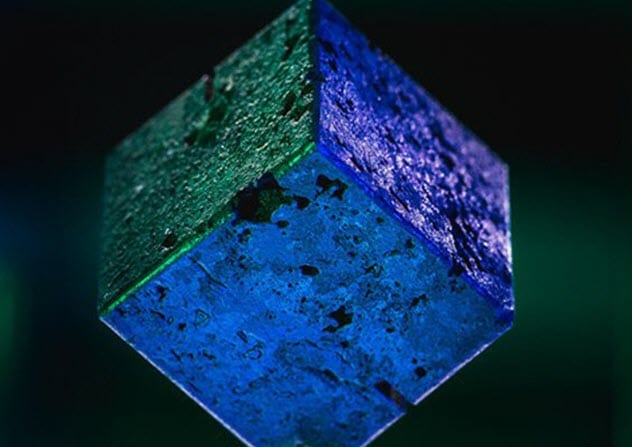 Space
Space  Space
Space  Food
Food 10 Quirky, but Necessary, Food Safety Rules of the Past
 Music
Music 10 Bands That Originally Had Terrible Names
 Weird Stuff
Weird Stuff 10 Unbelievably Bizarre Blunders
 History
History 10 Doomsday Scenes from the Year Without a Summer
 Technology
Technology 10 Surprising Truths About the Power Grid You Were Never Told
 Food
Food 10 Most Outrageous Restaurant Food Challenges
 Facts
Facts 10 Interesting and Bizarre Facts About Vending Machines
 Technology
Technology 10 Ancient “Smart” Materials Scientists Still Can’t Reproduce
 Gaming
Gaming 10 Games Milked for All Their Worth
 Space
Space 10 Crazy Ideas About Our Solar System
 Food
Food 10 Quirky, but Necessary, Food Safety Rules of the Past
 Music
Music 10 Bands That Originally Had Terrible Names
Who's Behind Listverse?

Jamie Frater
Head Editor
Jamie founded Listverse due to an insatiable desire to share fascinating, obscure, and bizarre facts. He has been a guest speaker on numerous national radio and television stations and is a five time published author.
More About Us Weird Stuff
Weird Stuff 10 Unbelievably Bizarre Blunders
 History
History 10 Doomsday Scenes from the Year Without a Summer
 Technology
Technology 10 Surprising Truths About the Power Grid You Were Never Told
 Food
Food 10 Most Outrageous Restaurant Food Challenges
 Facts
Facts 10 Interesting and Bizarre Facts About Vending Machines
 Technology
Technology 10 Ancient “Smart” Materials Scientists Still Can’t Reproduce
 Gaming
Gaming 10 Games Milked for All Their Worth
Top 10 Reasons To Be Fascinated By Cubes Today
The cube is a rock star among geometric shapes. These blocks can deliver medicine, move on their own, and allow humans to meet with intelligent dinosaurs. (Watch out, some of them are crabby.)
Besides toppling along the cutting edge of technology, cubes can reveal more about the past. Some of the most intriguing cases involve war secrets and why Plato’s nuttiest theory is true.
10 Explanations Of The Shapes Used For Everyday Things
10 Seattle’s Giant Ice Cube

When the Seattle Design Festival was held in 2016, architectural firm Olson Kundig wanted to showcase its work. Instead of displaying something that would shame the Eiffel Tower and bring fame to their brand, the firm brought a self-confessed “boring” item. It was a giant ice cube.
The frosty block stood 2.1 meters (7 ft) high and weighed 10 tons. It was raised in Occidental Square by someone who just stacked ice bricks together until the cube was completed.
It was a hit. Selfie-seekers flocked to the square. Both civilians and meteorologists placed bets on how fast the block might melt. Even NASA scientists ran the numbers to predict the cube’s life span, which was roughly a month long.[1]
9 This Cube Holds Intelligent Dinosaurs
During 2016, Queensland University invited dino addicts to step inside a massive cube. It was called, um, The Cube. The touch screen walls moved with Tyrannosaurus rex, nine other dinosaur species, and dinosaur-era reptiles. Their movements, sizes, and appearances were the most authentic to date.[2]
The Cube gave visitors the chance to read the latest information and virtually dig at archaeological sites. But the main attraction was the dinosaurs’ reactions to those who drew their attention. Not only could the creatures see visitors but artificial intelligence also allowed the animals to think about a person’s presence before deciding how they wanted to react.
Not all the reactions were pleasant. Indeed, the organizers asked for small children to be accompanied by their parents in case Quetzalcoatlus, the world’s largest-known pterosaur, threw a tantrum (which it did a few times).
8 Any Rubik’s Cube Is Solvable
The Rubik’s Cube is a popular brain game. However, many people throw in the towel after a few tries. Some throw the cube out the window. True enough, the puzzle can overwhelm a player with as many as 43 quintillion arrangements.
The good news?
Any Rubik’s Cube can be figured out in 20 steps or less. With enough speed and physical dexterity and by thinking a few steps ahead, anyone can solve even the most messed-up cube. Indeed, in 2017, when SeungBeom Cho was given a computer-scrambled Rubik’s Cube, he broke the world record after aligning the squares in just 4.59 seconds.[3]
7 Fastest Rubik’s Record Is Under Half A Second
The Rubik’s Cube fever is not limited to kids. (The last few record holders were young teens.) Roboticists and engineers also caught the bug. Several went all out to build a robot that could solve the cube faster than any person. In 2018, an MIT bot, called the Rubik’s Contraption, smoothly put human competitors on the shelf. It had just completed the cube in 0.38 seconds.[4]
The machine’s speed was not the only noteworthy thing. One might expect that only the finest upper-crust technology was used. But the designers gathered their materials cheaply on eBay, poached PlayStation cameras, and used their own custom-built parts. Once they added software to help the bot recognize the colors and sides, it needed only 21 moves to solve the riddle.
6 The Nakagin Capsule Tower

In 1972, Kisho Kurokawa was delighted when a building he had designed was erected in Tokyo. He hailed the tower as the beginning of a new era. But those who like space and builders who take their time might have a few issues with the Nakagin Capsule Tower.
It was built in only 30 days. The apartments are claustrophobic cubes going up to 13 stories high. Each is attached with only four bolts to one of two concrete cores.[5]
The shoebox homes were also designed to be replaced every 25 years. However, this proved to be too costly and the cubes were never replaced. Those who could no longer stand the limited space, miniature bathrooms, and crumbling cement moved out. But today, several residents remain in the unique building, which resembles a stack of washing machines from the outside.
10 Beautiful Examples of Symmetry In Nature
5 The Nazi Cubes

A few years ago, a cube arrived at the University of Maryland. The object was solid uranium. It weighed 2.3 kilograms (5 lb) and measured 5 centimeters (2 in) across. A note claimed that the cube had been taken from the nuclear reactor that Hitler had tried to build. When the Maryland physicists searched for more blocks, they discovered how close the Nazi regime had been to a nuclear program.[6]
German laboratories produced hundreds of these cubes during the 1940s when nations were racing to turn the atom into a powerful force. A handful of these blocks were tracked down, but each consisted of benign uranium. The latter cannot be used as a weapon, except to throw it at somebody’s head. To take it to the next level, the researchers lacked a certain something.
That “something” was as simple as teamwork. Together, the laboratories had what it took to create a working nuclear program. Instead, they behaved like rivals.
Germany’s defeat in World War II ultimately axed their nuclear dream. But had the scientists united, their work could have gone faster and ended in success. And the world today might be a very different place.
4 Dust-Sized Cubes That Deliver Medicine

The future of medicine is miniature miracles. One of the best is an invention from Johns Hopkins University. In 2005, they created metallic cubes that assembled themselves during production. But something else makes these objects valuable. They can hold and release medicine inside a patient’s body.
While it sounds dangerous to shoot somebody full of metal blocks, their size makes the cubes relatively harmless. They are no bigger than dust specks despite having six sides, hinges, and a layer of gold.
When the odd therapy becomes available, a cube-filled implant will treat everything from disorders and illnesses to injuries. Some kind of trigger, perhaps a remote-controlled frequency, will tell the blocks when to release the drugs.[7]
3 A Smart Swarm Of Cubes
In 2019, MIT shared a mesmerizing clip with the public. The footage showed tiny cubes with lives of their own. The blocks moved independently, rolling or jumping toward their destination. They sought out specific partners to stick to and used themselves like bricks to build structures. The cubes even followed light sources.[8]
The robots are called M-Blocks 2.0. Each has a fast-spinning flywheel for a heart. On the outside, bar codes and magnets enable the blocks to recognize each other. That way, they can spin in midair, shuffle around, and climb on top of other blocks to build what a program tells them to construct.
But these are not Lego blocks for the lazy. In the future, M-Blocks will be able to save lives. For example, they could group hug themselves into a bridge and allow stranded people to climb to safety.
2 A Cube Calculated A Marvel Villain’s Strength

Thanos is one of the most powerful Marvel villains. In 2018, a professor from Northeastern University wanted to know just how strong the purple terror was. But Steven Cranford needed something to help him determine Thanos’s physical prowess. For this, he turned to the Marvel movie Avengers: Infinity War. In it, Thanos smashes a cube called the Tesseract.
The cube may be fictional, but tesseracts are not. This geometric shape has four dimensions, with a cube hovering at the center of another cube. Cranford had to build his own tesseracts. Since doing so in real life is too hard, he created several 4-D cubes with special software that allowed him to piece them together. Atom by atom.[9]
Cranford experimented with different materials and sizes before he settled on a carbon-based replica. When he tested the replica’s strength, it became clear that Thanos had to wield a force equal to 42,000 tons to crush the fictional Tesseract. To put that into perspective, Thanos can lift the RMS Titanic like the Avengers can lift their teacups.
1 Earth Is Made Of Cubes

During the 5th century BC, Plato believed that the universe consisted of five elements—air, water, earth, fire, and cosmos. Plato gave each element a geometric shape. The element earth was a cube. More intriguingly, he claimed that the world was made of cubes.[10]
Although we know today that the planet is a sphere, the Greek philosopher displayed an eerie awareness of something researchers only recently discovered. Prompted by Plato’s belief that the planet is a cube-fest, scientists from the University of Pennsylvania went rock-gazing. To their amazement, they found that the average shape for rocks, whether they were dynamited or naturally broken, is the cube.
Plato was a master of geometry. Even so, it remains borderline freaky that he knew over 1,000 years ago that earth is largely a collection of cubes.
10 Mind-Bending Facts About Crop Circles








